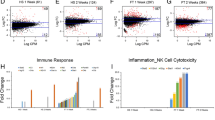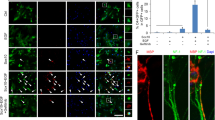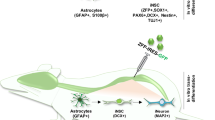Abstract
Our recent studies demonstrated that mature astrocytes from spinal cord can be reprogrammed in vitro and in vivo to generate neural stem/progenitor cells (NSPCs) following treatment with conditioned medium collected from mechanically injured astrocytes. However, little is known regarding the molecular mechanisms underlying the reprogramming of astrocytes. Here, we show that fibroblast growth factor 4 (FGF4) exerts a critical role in synergistically converting astrocytes into NSPCs that can express multiple neural stem cell markers (nestin and CD133) and are capable of both self-renewal and differentiation into neurons and glia. Lack of FGF4 signals fails to elicit the dedifferentiation of astrocytes towards NSPCs, displaying a substantially lower efficiency in the reprogramming of astrocytes and a slower transition through fate-determined state. These astrocyte-derived NSPCs displayed relatively poor self-renewal and multipotency. More importantly, further investigation suggested that FGF4 is a key molecule necessary for activating PI3K/Akt/p21 signaling cascades, as well as their downstream effectors responsible for directing cell reprogramming towards NSPCs. Collectively, these findings provide a molecular basis for astrocyte dedifferentiation into NSPCs after central nervous system (CNS) injury and imply that FGF4 may be a clinically applicable molecule for in situ neural repair in the CNS disorders.









Similar content being viewed by others
References
Caroni P, Savio T, Schwab ME (1988) Central nervous system regeneration: oligodendrocytes and myelin as non-permissive substrates for neurite growth. Prog Brain Res 78:363–370
Horner PJ, Gage FH (2000) Regenerating the damaged central nervous system. Nature 407(6807):963–970
Deumens R, Koopmans GC, Joosten EA (2005) Regeneration of descending axon tracts after spinal cord injury. Prog Neurobiol 77(1–2):57–89
Kim JB, Zaehres H, Wu G, Gentile L, Ko K, Sebastiano V, Araúzo-Bravo MJ, Ruau D, Han DW, Zenke M, Schöler HR (2008) Pluripotent stem cells induced from adult neural stem cells by reprogramming with two factors. Nature 454(7204):646–650
Kim JB, Sebastiano V, Wu G, Araúzo-Bravo MJ, Sasse P, Gentile L, Ko K, Ruau D, Ehrich M, van den Boom D, Meyer J, Hübner K, Bernemann C, Ortmeier C, Zenke M, Fleischmann BK, Zaehres H, Schöler HR (2009) Oct4-induced pluripotency in adult neural stem cells. Cell 136(3):411–419
Yamaguchi S, Hirano K, Nagata S, Tada T (2011) Sox2 expression effects on direct reprogramming efficiency as determined by alternative somatic cell fate. Stem Cell Res 6(2):177–186
Son EY, Ichida JK, Wainger BJ, Toma JS, Rafuse VF, Woolf CJ, Eggan K (2011) Conversion of mouse and human fibroblasts into functional spinal motor neurons. Cell Stem Cell 9(3):205–218
Picanco-Castro V, Russo-Carbolante E, Reis LC, Fraga AM, de Magalhães DA, Orellana MD, Panepucci RA, Pereira LV, Covas DT (2011) Pluripotent reprogramming of fibroblasts by lentiviral mediated insertion of SOX2, C-MYC, and TCL-1A. Stem Cells Dev 20(1):169–180
Ring KL, Tong LM, Balestra ME, Javier R, Andrews-Zwilling Y, Li G, Walker D, Zhang WR, Kreitzer AC, Huang Y (2012) Direct reprogramming of mouse and human fibroblasts into multipotent neural stem cells with a single factor. Cell Stem Cell 11(1):100–109
Lujan E, Chanda S, Ahlenius H, Südhof TC, Wernig M (2012) Direct conversion of mouse fibroblasts to self-renewing, tripotent neural precursor cells. Proc Natl Acad Sci U S A 109(7):2527–2532
Seri B, García-Verdugo JM, McEwen BS, Alvarez-Buylla A (2001) Astrocytes give rise to new neurons in the adult mammalian hippocampus. J Neurosci 21(18):7153–7160
Heins N, Malatesta P, Cecconi F, Nakafuku M, Tucker KL, Hack MA, Chapouton P, Barde YA, Götz M (2002) Glial cells generate neurons: the role of the transcription factor Pax6. Nat Neurosci 5(4):308–315
Lang B, Liu HL, Liu R, Feng GD, Jiao XY, Ju G (2004) Astrocytes in injured adult rat spinal cord may acquire the potential of neural stem cells. Neurosci 128(4):775–783
Berninger B, Costa MR, Koch U, Schroeder T, Sutor B, Grothe B, Götz M (2007) Functional properties of neurons derived from in vitro reprogrammed postnatal astroglia. J Neurosci 27(32):8654–8664
Yang H, Cheng XP, Li JW, Yao Q, Ju G (2009) De-differentiation response of cultured astrocytes to injury induced by scratch or conditioned culture medium of scratch-insulted astrocytes. Cell Mol Neurobiol 29(4):455–473
Heinrich C, Blum R, Gascón S, Masserdotti G, Tripathi P, Sánchez R, Tiedt S, Schroeder T, Götz M, Berninger B (2010) Directing astroglia from the cerebral cortex into subtype specific functional neurons. PLoS Biol 8(5):e1000373
Corti S, Nizzardo M, Simone C, Falcone M, Donadoni C, Salani S, Rizzo F, Nardini M, Riboldi G, Magri F, Zanetta C, Faravelli I, Bresolin N, Comi GP (2012) Direct reprogramming of human astrocytes into neural stem cells and neurons. Exp Cell Res 318(13):1528–1541
Yang H, Ling W, Vitale A, Olivera C, Min Y, You S (2011) ErbB2 activation contributes to de-differentiation of astrocytes into radial glial cells following induction of scratch-insulted astrocyte conditioned medium. Neurochem Int 59(7):1010–1018
Yang H, Feng GD, Olivera C, Jiao XY, Vitale A, Gong J, You SW (2012) Sonic hedgehog released from scratch-injured astrocytes is a key signal necessary but not sufficient for the astrocyte de-differentiation. Stem Cell Res 9(2):156–166
Sirko S, Behrendt G, Johansson PA, Tripathi P, Costa M, Bek S, Heinrich C, Tiedt S, Colak D, Dichgans M, Fischer IR, Plesnila N, Staufenbiel M, Haass C, Snapyan M, Saghatelyan A, Tsai LH, Fischer A, Grobe K, Dimou L, Götz M (2013) Reactive glia in the injured brain acquire stem cell properties in response to sonic hedgehog glia. Cell Stem Cell 12(4):426–439
Sher F, Boddeke E, Copray S (2011) Ezh2 expression in astrocytes induces their dedifferentiation toward neural stem cells. Cell Reprogram 13(1):1–6
Yang H, Qian XH, Cong R, Li JW, Yao Q, Jiao XY, Ju G, You SW (2010) Evidence for heterogeneity of astrocyte dedifferentiation in vitro: astrocytes transform into intermediate precursor cells following induction of ACM from scratch-insulted astrocytes. Cell Mol Neurobiol 30(3):483–491
Niswander L, Martin GR (1992) FGF-4 expression during gastrulation, myogenesis, limb and tooth development in the mouse. Development 114(3):755–768
Niswander L, Martin GR (1993) FGF-4 and BMP-2 have opposite effects on limb growth. Nature 361(6407):68–71
Feldman B, Poueymirou W, Papaioannou VE, DeChiara TM, Goldfarb M (1995) Requirement of FGF-4 for postimplantation mouse development. Science 267(5195):246–249
Kosaka N, Kodama M, Sasaki H, Yamamoto Y, Takeshita F, Takahama Y, Sakamoto H, Kato T, Terada M, Ochiya T (2006) FGF-4 regulates neural progenitor cell proliferation and neuronal differentiation. FASEB J 20(9):1484–1485
Basilico C, Ambrosetti D, Fraidenraich D, Dailey L (1997) Regulatory mechanisms governing FGF-4 gene expression during mouse development. J Cell Physiol 173(2):227–232
Webb SE, Lee KKH, Tang MK, Ede DA (1997) Fibroblast growth factors 2 and 4 stimulate migration of mouse embryonic limb myogenic cells. Dev Dyn 209(2):206–216
Yuan H, Corbi N, Basilico C, Dailey L (1995) Developmental-specific activity of the FGF-4 enhancer requires the synergistic action of Sox2 and Oct-3. Genes Dev 9(21):2635–2645
Ye W, Shimamura K, Rubenstein JL, Hynes MA, Rosenthal A (1998) FGF and Shh signals control dopaminergic and serotonergic cell fate in the anterior neural plate. Cell 93(5):755–766
Shamim H, Mahmood R, Logan C, Doherty P, Lumsden A, Mason I (1999) Sequential roles for FGF4, En1 and Fgf8 in specification and regionalisation of the midbrain. Development 126(5):945–959
Yamamoto H, Ochiya T, Takahama Y, Ishii Y, Osumi N, Sakamoto H, Terada M (2000) Detection of spatial localization of Hst-1/Fgf-4 gene expression in brain and testis from adult mice. Oncogene 19(33):3805–3810
Tanaka S, Kunath T, Hadjantonakis AK, Nagy A, Rossant J (1998) Promotion of trophoblast stem cell proliferation by FGF4. Science 282(5396):2072–2075
Van Praag H, Schinder AF, Christie BR, Toni N, Palmer TD, Gage FH (2002) Functional neurogenesis in the adult hippocampus. Nature 28(6875):1030–1034
Mayshar Y, Rom E, Chumakov I, Kronman A, Yayon A, Benvenisty N (2008) Fibroblast growth factor 4 and its novel splice isoform have opposing effects on the maintenance of human embryonic stem cell self-renewal. Stem Cells 26(3):767–774
Yang H, Liang Z, Li JW, Cheng XP, Luo N, Ju G (2006) Optimized and efficient preparation of astrocyte cultures from rat spinal cord. Cytotechnology 52(2):87–97
Yang H, Cheng X, Yao Q, Li J, Ju G (2008) The promotive effects of thymosin beta4 on neuronal survival and neurite outgrowth by upregulating L1 expression. Neurochem Res 33(11):2269–2280
Xu X, Yang H, Lin YF, Li X, Cape A, Ressler KJ, Li S, Li XJ (2010) Neuronal Abelson helper integration site-1 (Ahi1) deficiency in mice alters TrkB signaling with a depressive phenotype. Proc Natl Acad Sci U S A 107(44):19126–19131
Hunt J, Cheng A, Hoyles A, Jervis E, Morshead CM (2010) Cyclosporin A has direct effects on adult neural precursor cells. J Neurosci 30(8):2888–2896
Avecilla ST, Hattori K, Heissig B, Tejada R, Liao F, Shido K, Jin DK, Dias S, Zhang F, Hartman TE, Hackett NR, Crystal RG, Witte L, Hicklin DJ, Bohlen P, Eaton D, Lyden D, de Sauvage F, Rafii S (2004) Chemokine-mediated interaction of hematopoietic progenitors with the bone marrow vascular niche is required for thrombopoiesis. Nat Med 10(1):64–71
Yun YR, Won JE, Jeon E, Lee S, Kang W, Jo H, Jang JH, Shin US, Kim HW (2010) Fibroblast growth factors: biology, function, and application for tissue regeneration. J Tissue Eng 2010:218142
Dai C, Celestino JC, Okada Y, Louis DN, Fuller GN, Holland EC (2001) PDGF autocrine stimulation dedifferentiates cultured astrocytes and induces oligodendrogliomas and oligoastrocytomas from neural progenitors and astrocytes in vivo. Genes Dev 15(15):1913–1925
Buffo A, Rite I, Tripathi P, Lepier A, Colak D, Horn AP et al (2008) Origin and progeny of reactive gliosis: a source of multipotent cells in the injured brain. Proc Natl Acad Sci U S A 105(9):3581–3586
Nakagomi T, Molnar Z, Nakano-Doi A, Taguchi A, Saino O, Kubo S, Clausen M, Yoshikawa H, Nakagomi N, Matsuyama T (2011) Ischemia-induced neural stem/progenitor cells in the pia mater following cortical infarction. Stem Cells Dev 20(12):2037–2051
Park JY, Schutzer WE, Lindsley JN, Bagby SP, Oyama TT, Anderson S, Weiss RH (2007) p21 is decreased in polycystic kidney disease and leads to increased epithelial cell cycle progression: roscovitine augments p21 levels. BMC Nephrol 8:12. doi:10.1186/1471-2369-8-12
Felekkis KN, Koupepidou P, Kastanos E, Witzgall R, Bai CX, Li L, Tsiokas L, Gretz N, Deltas C (2008) Mutant polycystin-2 induces proliferation in primary rat tubular epithelial cells in a STAT-1/p21-independent fashion accompanied instead by alterations in expression of p57KIP2 and Cdk2. BMC Nephrol 9:10. doi:10.1186/1471-2369-9-10
Acknowledgments
We thank Dr. Gabi and Prof. Wang Wei for critical reading of the manuscript. This work was supported by the Natural Science Foundation of China (grant nos. 30973088, 81371411, 81071486, and 81171137) and National High-Tech R&D Program of China (863 Program) 2006AA02Z157.
Conflict of Interest
The authors declare no conflicts of interest.
Author information
Authors and Affiliations
Corresponding authors
Additional information
Guo-Dong Feng and Bao-Rong He contributed equally to this work.
Rights and permissions
About this article
Cite this article
Feng, GD., He, BR., Lu, F. et al. Fibroblast Growth Factor 4 Is Required but not Sufficient for the Astrocyte Dedifferentiation. Mol Neurobiol 50, 997–1012 (2014). https://doi.org/10.1007/s12035-014-8649-1
Received:
Accepted:
Published:
Issue Date:
DOI: https://doi.org/10.1007/s12035-014-8649-1




